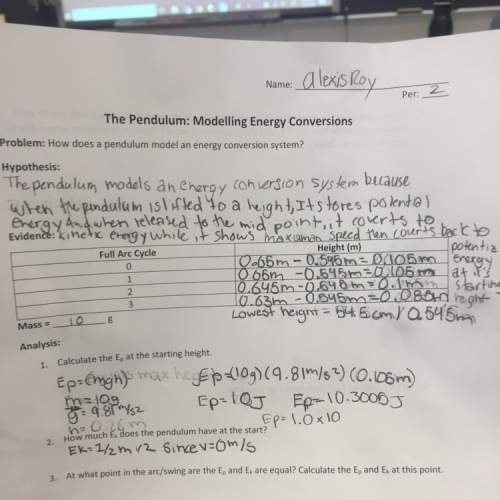
Physics, 18.04.2020 01:19, townselt3861
The potential energy an object has due to it position Is called potential energy

Answers: 3
Other questions on the subject: Physics

Physics, 21.06.2019 19:30, davidsteck99
A33.1 g copper object is launched from a 1.5 m 30° steel incline positioned on the floor by being pulled up a string attached to a 50.0 g mass suspended vertically over a pulley. the object is projected towards a glass table where it lands when it is at the point along its trajectory with the lowest speed. it comes to a halt when it clears the opposite edge of the table. it then falls and lands on 9 physics texts each 5 cm thick that are stacked on the floor on the opposite side of the table. assume that the table does not have a ledge and the rectangular object experiences 0.05 n of air resistance as it falls towards the books. how far and how long did the object travel and how fast does it hit the books. assume that at the moment the copper object leaves the incline, the massless string and ideal pulley break off
Answers: 2

Physics, 21.06.2019 22:00, baidentheodore617
Let v1, v2, w be three linearly independent vectors in r 3 . that is, they do not all lie on the same plane. for each of the following (infinite) set of vectors, carefully sketch it in r 3 , and determine whether or not it is a vector space (i. e., a subspace of r 3 ). explain your reasoning
Answers: 2

Physics, 22.06.2019 00:30, Solany6426
Part f - example: finding two forces (part i) two dimensional dynamics often involves solving for two unknown quantities in two separate equations describing the total force. the block in (figure 1) has a mass m=10kg and is being pulled by a force f on a table with coefficient of static friction îľs=0.3. four forces act on it: the applied force f (directed î¸=30â above the horizontal). the force of gravity fg=mg (directly down, where g=9.8m/s2). the normal force n (directly up). the force of static friction fs (directly left, opposing any potential motion). if we want to find the size of the force necessary to just barely overcome static friction (in which case fs=îľsn), we use the condition that the sum of the forces in both directions must be 0. using some basic trigonometry, we can write this condition out for the forces in both the horizontal and vertical directions, respectively, as: fcosî¸â’îľsn=0 fsinî¸+nâ’mg=0 in order to find the magnitude of force f, we have to solve a system of two equations with both f and the normal force n unknown. use the methods we have learned to find an expression for f in terms of m, g, î¸, and îľs (no n).
Answers: 2

Physics, 22.06.2019 03:30, itsRyanPlayzMC9660
Scout feels ill one day before school. her mother puts a thermometer in her mouth and the temperature begins to climb to 100°f. what is happening between the cooler thermometer and scout's body? a) scout's body is applying a force to the particles in the thermometer. b) kinetic energy is being transferred from her mouth to the thermometer. c) potential energy is being lost by the thermometer and gained by scout's body. d) the potential energy stored in foods is converted to mechanical energy to raise the mercury in the thermometer.
Answers: 1
Do you know the correct answer?
The potential energy an object has due to it position Is called potential energy...
Questions in other subjects:

Computers and Technology, 09.04.2020 21:00

Law, 09.04.2020 21:00

Mathematics, 09.04.2020 21:00

Mathematics, 09.04.2020 21:00





Mathematics, 09.04.2020 21:00

Mathematics, 09.04.2020 21:00







